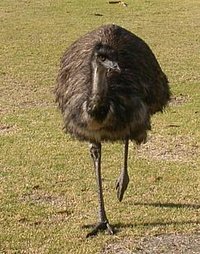Ratite
|
|
| Ratites | ||||||||
|---|---|---|---|---|---|---|---|---|
 Emu | ||||||||
| Scientific classification | ||||||||
| ||||||||
| Families | ||||||||
A ratite is any of a diverse group of large, flightless birds of Gondwanian origin, most of them now extinct. All extant species belong to the order Struthioniformes; some extinct species belong to Struthioniformes, while some belong to Aepyornithiformes. Unlike other flightless birds, the ratites have no keel on their sternum and, lacking a strong anchor for their wing muscles, could not fly even were they to develop suitable wings.
Most parts of the former Gondwana have ratites, or have had until the fairly recent past.
- The African Ostrich is the largest living ratite. A large specimen can be 3 metres tall, weigh 135 kilograms, and outrun a horse.
- Aepyornis, the 'elephant bird' of Madagascar was the largest bird ever known. Although shorter than the tallest moa, a large one could weigh 450 kilograms. There were two species when humans arrived from Borneo and Africa, probably in the 1st Century AD. Both seem to have survived for a time: the smaller Aepyornis mullerornis probably disappearing first, the giant Aepyornis maximus may have existed until as late as 1600.
- Of the living species, the Australian Emu is next in size, reaching two metres and about 60 kilograms. Like the ostrich, it is a fast-running, powerful bird of the open plains and woodlands.
- Also native to Australia and the islands to the north, are the three species of cassowary. Shorter than an Emu and very solidly built, cassowaries prefer thickly vegetated tropical forest. They can be very dangerous when surprised or cornered. In New Guinea, cassowary eggs are brought back to villages and the chicks raised for eating as a much-prized delicacy, despite (or perhaps because of) the risk they pose to life and limb.
- The extensive moa family of New Zealand had 10 different species until humans began arriving in numbers at about 1300AD. Like the cassowaries, moa were mostly forest dwellers without any mammalian predators. They are believed to have been brought to extinction by hunting within a few hundred years of human settlement. However, some believe small populations may have survived in isolated regions until more recent times.
- The smallest ratites are the six species of kiwi from New Zealand. Kiwi are chicken-sized, shy, and stroppy. They nest in deep burrows and use a highly developed sense of smell to find small insects and grubs in the soil. Kiwi are notable for laying eggs that are very large in relation to their body size. A kiwi egg may equal 15 to 20 percent of the body mass of a female kiwi.
- South America has two species of rhea, mid-sized, fast-running birds of the pampas. The larger American Rhea grows to about 1.5 metres tall and weighs 20 to 25 kilograms. (South America also has 73 species of the small, ground-dwelling but not flightless tinamou family, which is distantly related to the ratite group.)
The traditional account of ratite evolution has the order emerging in Gondwana in cretaceous times, then evolving in their separate directions as the continents drifted apart. Cladistic evidence for this is strong: ratites share too many features for their current forms to be easily explained by convergent evolution. However, recent analysis of genetic variations between the ratites conflict with this: DNA analysis appears to show that the ratites diverged from one another too recently to share a common Gondwanian ancestor, and suggest that the kiwis are more closely related to the cassowaries than the moa. At present there is no generally accepted explanation. Research continues.da:Strudsefugle de:Laufvögel fr:Struthioniforme it:Struthioniformes nl:Struthioniformes ja:ダチョウ目 pl:Strusie pt:Struthioniformes sl:nojevci zh:å¤é¢æ»ç®
